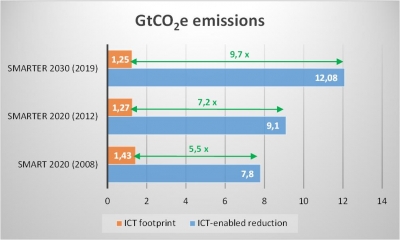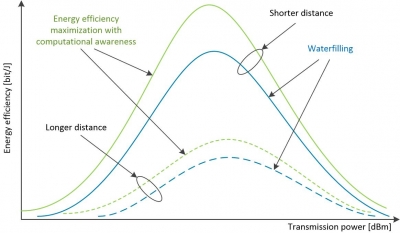Hanna Bogucka, Filip Idzikowski, and Bartosz Bossy
Published: 10 Sep 2020

CTN Issue: August 2020

A note from the editors:
The ever-increasing demand for connectivity and bandwidth by billions of devices worldwide has made it difficult for wireless networks and computing devices to limit the total communications energy consumption and associated carbon footprint. Green communications and computing is a field that aims to maximise the energy efficiency through system-level approaches. In this article, Hanna Bogucka, Filip Idzikowski, and Bartosz Bossy present an overview of Green communications and computing, summarizing techniques that have already shown great promise to maximize the energy efficiency in different layers of the network, and the resulting performance of such "Green architectures". They argue that these ongoing and future efforts are essential to limit and stabilise the carbon footprint of the ICT sector including wireless networks. So, are Green networks a necessity or a hopeless endeavour? Your feedback and comments are welcome.
Muhammad Zeeshan Shakir, CTN Editor
Alan Gatherer, CTN Editor-in-Chief
Energy-Efficiency in Future Massive Communication and Computing Networks
I. Is ICT Eco?
In the era of ubiquitous Internet access, exponential growth of telecommunication traffic is observed. According to the Ericsson Mobility Report [1] there will be 8,9 billion mobile subscriptions in 2025, out of which 2.8 billion Fifth Generation (5G) subscriptions are forecast. This number adds to 24,6 billion of machines and devices comprising future Internet of Things (IoT)1. The mobile data traffic will reach almost 2 zettabytes annually in 2025. Moreover, data traffic increased by 20–100 percent as a consequence of COVID-19 lockdowns [1]. Particularly in times of crisis, digital communication capabilities need to be supported.
Together with the rapid development of modern Information and Communication Technologies (ICT), energy consumption increases, although it is not easy to derive the exact translation of the data traffic volume to energy consumption (in particular fossil energy carriers consumption) and greenhouse gas (GHG) emissions2. According to the well-known SMART2020 report [2] of the Global eSustainability Initiative (GeSI) Climate Group, the ICT carbon footprint (CO2e3 emissions) was supposed to increase from 0.53 Gt CO2e in 2002 to 1.43 Gt by 2020. However, newer reports, i.e. SMARTer2020 [3] and SMARTer2030 [4] corrected these predictions, and showed stabilized (slightly decreasing) trend in the ICT footprint (1,27 GtCO2e in 2020 [3] and 1,25 GtCO2e in 2030 [4]).

Figure 1. ICT benefits factor in 2020 and 20304
These recent reports focus on opportunities brought by ICT to other business sectors. This is because of the 169 imbedded targets of sustainable development goals (SDGs) created by the United Nations to be achieved by 2030, 103 are directly influenced by these technologies, with established examples of deployment (reported in [4]). Although the ICT sector’s own emissions are expected to stabilize to 1.25 GtCO2e in 2030, specific ICT opportunities identified in [2]-[4] should lead to emission reductions in ICT –enabled sectors seven times the size of the sector’s own footprint by 2020 [3], and more than nine times by 2030 [4] of total emissions (see Fig. 1). Moreover, analyses in [4] show that ICT has the potential to enable a 20% reduction of global CO2e emissions by 2030, holding them at 2015 levels. Furthermore, [1] provides some interesting articles on how ICT contributes to the low-carbon economy, and on decoupling energy from the traffic growth.
The above mentioned reports sound like very good news, however, expectations that green ICT will lower the energy costs, and save the environment is based on potential future developments. An analytical model to investigate the potentials and risks of digitalization, green IT and ICT for decoupling the economic growth from energy consumption and carbon footprint is presented in [5]. The conclusions from using this thorough model are that the hopes set on digitalization reducing energy consumption have not yet been justified. The energy-increasing effects (direct effects and economic growth) of digitalization so far have been greater than the energy-reducing effects.
II. Green Communication and Green Computing
Reduced-energy wireless communication has been in the focus of research and industry interest for recent years, aiming at achieving 10 times the energy efficiency in the Fifth Generation (5G) radio systems compared with the Fourth Generation (4G) of these systems [6]. Moreover, so-called zero-energy radios are envisioned for future Sixth Generation (6G) systems as their technology enablers [7]. According to this vision, drivers from society, including UN SDGs, will shape 6G communication systems. Moreover, reduction of the communication network energy consumption will be a critical requirement for these future systems.
There are some well-known methods for saving energy in radio access networks. As illustrated by Figure 2, they can be grouped in the following systematic areas: i) topology-related methods, ii) network management, iii) connections architecture adaptation, iv) radio resource management, v) link adaptation and vi) physical components design and optimization.

Regarding the core (wired) network, power consumption of networking equipment currently mainly depends on the number of active devices. Power consumption of these devices has little dependence on the actual traffic load across all the network segments. Therefore current energy saving approaches mainly focus on exploiting traffic dynamics to deactivate unnecessary resources. They can be classified in three groups: i) dynamic traffic engineering, ii) proxying/virtualization and iii) rate adaptation [8]. However, more fundamental approaches are applicable within the 5G and 6G horizon. They include an energy-efficient architecture as well as design of energy-efficient devices [8] having various modes of operation with quick activation times, reconfigurations upon failures, smart levels of overprovisioning, optical bypassing, etc.
One of the goals of the so-called green computing is to maximize energy efficiency during computing devices lifetime5. Approaches to this energy-efficiency include i) data center design, ii) software and deployment optimization, iii) power management, iv) optimized cloud computing, v) supercomputers, vi) edge and fog computing. Regarding data centers, their energy consumption (resulting from IT equipment operation as well as from heating, ventilation and air conditioning) accounts for 1.1–1.5% of the world's total energy use [9]. Regarding software and deployment optimization of the computing machines, algorithmic efficiency, optimized computing resource allocation, machines virtualization and the use of terminal servers are in place to reduce the energy consumption caused both by the computers themselves and their cooling systems. Power management allows a system to automatically turn off or hibernate components in case of user’s inactivity. Cloud computing allows companies for significant reduction of their direct energy consumption by moving their specific on-site applications to the cloud. Supercomputers that may reside in a cloud are getting more and more efficient in terms of performance-per-watt, some of them exceeding 16 GFLOPS/watt. However, as pointed by a Greenpeace study, data centers (the cloud) represent 21% of the electricity consumed by the IT sector, which is about 382 billion kWh a year [10].
III. Communication and Computing Greening Together
It is important to stress that IoT services involve both communication and computing (processing) of information across the network, and thus, key performance indicators including energy-efficiency of communication and computing should be handled jointly. One of the metrics (and main criterion for the algorithm evaluation) that could be proposed is the total number of successfully conveyed (transmitted, processed and received) bits per cost-unit (energy unit or related monetary unit).
The challenges of future massive, yet energy-efficient, communication and computing require new architectural and algorithmic approach to the network design. So far, access to cloud services has been considered as the mainstream enabler for IoT communication and computing. A cloud is commonly understood as a server offering huge memory-capacity for data storing, sharing and analysis, a super-computer with optimized computing algorithms for these data processing, or as a service for end devices connected to IoT. The cloud ecosystem is centralized, thus, requiring transmission of data to long distances. Data centers and cloud servers may be located thousands kilometers away from the user. This, in turn, results in considerable delays, transmission errors and energy cost associated with the use of network resources, although cloud servers may be very effective in terms of the computing energy cost.
The other extreme approach to the IoT communication and computing challenges is fully distributed operation and organization of a network called edge computing. In this case, networking is based on cooperation of networked devices and computing-resource sharing. The basic challenges here are: to assure dynamic adaptation to the changing network traffic and topology, to design context-responsive (context-aware) information processing algorithms, to facilitate dynamic connections and access to the network, to support cooperation and communication/computing resources sharing, to guarantee the quality of service as well as security and privacy of distributed information. The edge devices are not that computationally powerful and energy-optimized as the cloud servers, they require more energy per processed bit, but the communication to long distances and the associated energy cost is avoided.
Fog network architecture has been proposed as more suited for future IoT communication and computing services than centralized (cloud-based) or totally distributed (edge-computing) ones. It can be flexibly organized and managed in response to the variety of 5G/6G envisioned services and their challenges. This architecture is promoted as multi-tier and hierarchical, consisting of the things (edge devices) tier, fog tier and cloud tier [11] and is presented in Figure 3.

In the things tier, IoT end-devices are connected, such as smartphones, tablets, sensors, vehicular communication transceivers, remote-control devices, robots, etc. In the cloud tier, high computing-performance and high memory-capacity servers are placed. In the fog tier, computing machines (microcomputers, personal computers, computer clusters, base-stations, etc.) capable of data processing and analysis, and of communication and cooperation are located. It is important to note that the fog tire can have multiple hierarchical layers, and that communication and cooperation between them is not only vertical, but also horizontal.
In Figure 3, arrows illustrate the data flow in a few use-cases (computations/tasks offloading, multimedia cashing, vehicle-to-vehicle/infrastructure/anything communication, remote control in robotics and data processing). An arrow’s line weight represents the data volume. For example (the orange-arrow case in Figure 3), information content of a large volume, e.g., video, can be acquired by a network of sensors (or cameras), transmitted to a fog node and processed there to extract some specific features. Information of a lower volume, e.g., mentioned features, is transmitted to a data center (a cloud) for storage and some further processing, the result of which, e.g. decision on detected features, might be accessed by interested parties in a larger area covered by a cloud. Another example (red-arrows case in Figure 3) of exploiting the fog architecture is to delegate computational tasks by a smartphone with small computational power to fog nodes with higher computational capabilities.
In general, the fog architecture offers opportunities for sharing (and thus, uberization) of resources: computational-, communication-, storage- or energy-resources [11]-[13]. It allows for joint (communication- and computing-related) optimization of energy efficiency. Naturally, there is a trade-off between delay, reliability, and energy consumption in the fog, e.g. computing machines in the fog nodes may consume more energy per operation than optimized cloud servers, but provide lower latency [12]. High computational complexity of the processing requests favors processing in a cloud. Delay and power consumption caused by transmitting data through the core network is offset by the high processing speed and computational power efficiency. Conversely, requests which require relatively few operations to process are best served by nearby edge devices or fog nodes.
Finally, the goal of reducing the network energy consumption may not be exactly the goal of a mobile IoT devices that are powered by batteries. In [13], we answer the question whether it is beneficial from the power consumption perspective to perform computations locally by the IoT device or to offload them to the fog. Research prove that usage of fog resources reduces IoT device power consumption mostly in case of short transmission distances, broad transmission bandwidth, and relatively high computational complexity of a task, e.g., more than 300 FLOPs per bit of compressed video stream. Numerical values are valid for the considered, realistic system parameters, but the general trend is expected to be valid for most setups.
IV. Computational Awareness in Links and Networks
On the completion of 3GPP Release 15, the first full set of 5G standards has been defined in 2018, and updated in 2019 and completed with Release 16 in 2020. As in the 4G standard, the Orthogonal Frequency Division Multiplexing (OFDM) has been proposed for 5G systems. Popularity of the OFDM technique results from its known advantages, one of them being adaptation potential to channel conditions. The flexibility in Resource Blocks (RBs) allocation and adaptive modulation and coding schemes (MCSs) may be utilized to maximize the offered transmission rate or minimize the energy consumption. Contrarily to the traditional approach to optimize the transmission parameters in response to channel quality, [14]-[17] look at advanced power-consumption models and optimization of the energy-efficiency (EE) metric defined as the number of successfully transmitted and received bits per Joule. This power consumption modelling must take signal-processing (with necessary computations) power into account. Intelligent utilization of such a model in the link- [14][15] and network- [16][17] energy-efficiency optimization algorithms, can be called computational awareness.
Depending on the link quality (and distance), power consumption of different causes, e.g. RF signal radiation or signal processing, may dominate over each other, and may be worth minimization for overall energy-efficiency. For example, power consumption related to the application of advanced coding schemes and, in particular, computationally-exhaustive decoding, may be higher than transmission power in short links, where the channel quality is good. In Figure 4, trends are shown for the computationally-aware link-adaptation in OFDM. There, one can see that this awareness results in higher EE than the rate-maximizing water-filling algorithm. The exact numbers depend on the specific scenario, some indicative figures can be found in [14][15].

In a more advanced network scenarios, such as relay (decode-and-forward -DF) interference networks, incorporation of the computational awareness in link-adaptation, dynamic cooperation-mode selection and relay-node selection algorithms results in increased energy-efficiency of the network, when compared to standard solutions. Relevant results and comparisons are provided in [16][17]. For example, Figure 5 shows that computational-awareness in energy-efficiency optimization implies that the cooperative mode is selected by some users even though interference is observed in the second time slot of relaying, and additional computations are necessary in the DF operation. This is because of high interference-channel attenuations, and relatively low communication- and computation- energy cost for these users (located at short distance from the relay).

Note that, in future massive communication in IoT, many devices may be transmitting on short links, many of them may serve as relays, and therefore application of computational awareness in such networks is crucial. The challenges are to develop distributed algorithms and assure this awareness. Moreover, the optimization algorithm itself also consumes energy, that needs to be taken into account.
V. Conclusions
All reports and forecasts for 10 years horizon show that ICT business is, and will be doing very well. However it also faces the existential challenge from climate change. The expectations are that the ICT sector will not only reduce its own carbon footprint, but also deliver significant reductions in CO2e emissions to other business sectors. The pressure is on researchers, engineers, business and governments to apply innovations, strategies and ambitious policies that could reverse the growth of the ICT sector footprint and enable global emissions reduction.
Over 3 trillion US Dollars is likely to be spent on research and development in the ICT sector up to 2030, indicating huge potential for innovative solutions to the SDGs [4]. Some promising technologies for greening communication and computing in future massive-type of networks are at the maturation stage and have been presented above.
[1] Most of them will be connected wirelessly based on “plug-in and forget” principle, which implies easy installation and battery-based operation with low energy consumption.
[2] Regarding mobile data communication, it is estimated that 1 Petabyte translates to 1 GWh of energy consumption.
[3] The Equivalent Carbon Dioxide (CO2e) is a term for describing different greenhouse gases in a common unit. For any quantity and type of greenhouse gas, CO2e signifies the amount of CO2 which would have the equivalent global warming impact.
[4] Based on the slideshow by Luis Neves, GeSI Chairman, "#SMARTer2030: ICT - Disruptive Technologies for Sustainable and Better Living” at 5th ITU Green Standards Week, Nassau, The Bahamas.
[5] There are other goals related to reduction of hazardous materials and factory waste, recyclability or biodegradability, which we do not address here.
Acknowledgement
The presented ideas have been worked out within the FAUST project (no. PL-TW/V/3/2018) funded by the National Centre of Research and Development, Poland.
References
- The Ericsson Mobility Report, June 2020, https://www.ericsson.com/49da93/assets/local/mobility-report/documents/2020/june2020-ericsson-mobility-report.pdf
- Global e-Sustainability Initiative, The Climate Group, “SMART 2020: Enabling the low carbon economy in the information age”, 2008 https://www.theclimategroup.org/sites/default/files/archive/files/Smart2020Report.pdf
- Global e-Sustainability Initiative, The Boston Consulting Group, “GeSI SMARTer 2020: The Role of ICT in Driving a Sustainable Future”, 2012, https://gesi.org/research/gesi-smarter2020-the-role-of-ict-in-driving-a-sustainable-future
- Global e-Sustainability Initiative and Deloitte, “Digital with Purpose: Delivering a SMARTer2030”, 2019, https://gesi.org/research/gesi-digital-with-purpose-full-report
- S. Lange, J. Pohl, T. Santarius, “Digitalization and energy consumption. Does ICT reduce energy demand?”, Ecological Economics, Vol. 176, Oct. 2020, 106760
- EU 5G Infrastructure Public Private Partnership Association, “5G Vision: the next generation of communication networks and services”, 2015 https://5g-ppp.eu/wp-content/uploads/2015/02/5G-Vision-Brochure-v1.pdf
- M. Latva-aho, K. Leppänen (eds.), “Key drivers and research challenges for 6G ubiquitous wireless intelligence”, 6G Research Visions 1, Sept. 2019, ISBN 978-952-62-2353-7
- F. Idzikowski, L. Chiaraviglio, A. Cianfrani, J. López Vizcaíno, M. Polverini, Y. Ye, “A Survey on Energy-Aware Design and Operation of Core Networks”, IEEE Communications Surveys & Tutorials, 2016, Vol. 18, No. 2, pp. 1453 – 1499
- S. Mittal, “A survey of techniques for improving energy efficiency in embedded computing systems”, International Journal of Computer Aided Engineering and Technology, Inderscience Publishers, 2014, 6 (4), pp.440-459.
- G. Cook, et.al., "Clicking Clean: Who Is Winning the Race to Build a Green Internet", Greenpeace study 2017.
- M. Chiang, B.h Balasubramanian, F. Bonomi (Eds.), Fog for 5G and IoT, Information and Communication Technology Series, Wiley; 1 edition (March 27, 2017)
- B. Kopras, F. Idzikowski, P. Kryszkiewicz, „Power Consumption and Delay in Wired Parts of Fog Computing Networks”, IEEE Sustainability through ICT Summit (StICT), 2019, 18-19 June 2019, Montréal, QC, Canada,
- P. Kryszkiewicz, F. Idzikowski, B. Bossy, B. Kopras, H. Bogucka, "Energy Savings by Task Offloading to a Fog Considering Radio Front-End Characteristics”, IEEE International Symposium on Personal, Indoor and Mobile Radio Communications (PIMRC), 8-11 Sept. 2019, Istanbul, Turkey
- B. Bossy, H. Bogucka, “Optimization of Energy Efficiency in Computationally-Aware Adaptive OFDM Systems”, IEEE International Symposium on Personal, Indoor and Mobile Radio Communications – PIMRC’2016, 4-7 Sept. 2016, Valencia, Spain
- B. Bossy, P. Kryszkiewicz, H. Bogucka, “Optimization of Energy Efficiency in the Downlink LTE Transmission”, IEEE International Conference on Communications, ICC 2017, 22-25 May, 2017, Paris, France
- B. Bossy, P. Kryszkiewicz, H. Bogucka, “Energy Efficient Resource Allocation in Multiuser DF Relay Interference Networks”, IEEE Global Communications Conference: Workshops: Green and Sustainable 5G Wireless Networks, GLOBECOM 2018, 9-13 December 2018, Abu Dhabi, UAE
- B. Bossy, P. Kryszkiewicz, H. Bogucka, „Energy Efficient Wireless Relay Networks with Computational Awareness”, IEEE Transactions on Communications, Vol. 68, No. 2, Feb. 2020, pp. 825 - 840
Statements and opinions given in a work published by the IEEE or the IEEE Communications Society are the expressions of the author(s). Responsibility for the content of published articles rests upon the authors(s), not IEEE nor the IEEE Communications Society.
Comments
Thanks for your comments. I am in the middle of watching a forum on ORAN for 5G and similar comments were made by Steve Papa. I will get the article authors to respond more fully.
Thanks
Alan Gatherer EIC
Submitted by gatherer@ieee.org on 21 September 2020
Thank you for your comment, which I agree 100% with. Seems that nothing comes for free: higher data rates means more energy or more bandwidth or more infrastructure (also translating to energy consumption). I think, that current solutions are developed to not waste rather than to reduce the absolute volume of ICT (including wireless communication) energy. That is to say, we look at flexible/adaptive techniques to better respond (energy-wise) to the QoS requirements, including sleep modes that you mention. Good news is that it seems to be good deal (green deal?) because ICT significantly reduces the carbon footprint caused by other business sectors.
Thanks for interesting discussion.
Hanna Bogucka
Submitted by hanna.bogucka@… on 5 October 2020
And thank you for your response and confirming my rough analysis is on the right track. The mounting shift of data traffic to wireless networks (both mobile and WLAN) will require greater attention to maintaining energy efficiency let alone achieving higher efficiency.
Terence Smith
Submitted by tjsmith@ieee.org on 6 October 2020






I’d like to thank CTN and authors for this article, it addresses an issue I am trying to come to grips with; what is energy efficiency price for 5G?
Achieving high energy efficiency in any ICT wireless network is difficult compared to fixed networks. A number published papers have shown that the power consumed in the various network components used in delivering data to the receiving devices is highest in the wireless network component, e.g. Preist. et al, “Analyzing End-to-End Energy Consumption for Digital Services.”
The Figure 2 item 6, Components, I think, may be the most difficult, but also the most critical, approach to achieving an improved energy efficiency. Adopting OFDM for mobile wireless introduces energy efficiency challenges along with the carrier flexibility it offers. For example, it has a high PAPR compared to other forms of modulation and a higher PA linearity. These two factors alone have a power usage impact. The late Earle McCune explored these matters in his article This Emperor Has No Clothes? In addition, 5G can only achieve its QoE goals by using wide bandwidth channels in the mmWave spectrum, the first mobile wireless generation to do so. 5G does offer much higher data transmission rates which tends to show its energy efficiency in a good light when expressed as Joules/GB. I am aware 3GPP is attempting to address the issue in its standards, but as I understand it, mostly by introducing new operational aspects to the standard, such as, base station standby modes. How successful this approach might be remains to be seen.
So, reducing 5G network energy consumption will be a real challenge.
Submitted by tjsmith@ieee.org on 16 September 2020